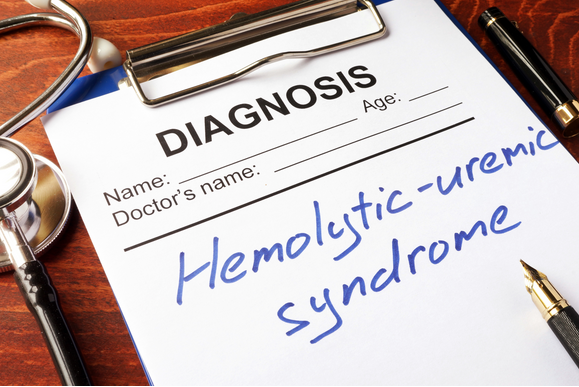- Stefania Milione
- Review
Hemolytic Uremic Syndrome
- 2/2019-giugno
- ISSN 2532-1285
- https://doi.org/10.23832/ITJEM.2019.020
Stefania Zampogna1, Valentina Talarico2, Maria Novella Pullano3, Maria De Filippo4, Riccardo Lubrano5
1) Pediatric First Aid, Unit of Pediatrics, “Pugliese-Ciaccio” Hospital, Catanzaro, Italy
2) Unit of Pediatrics, “Pugliese-Ciaccio” Hospital, Catanzaro, Italy
3) Unit of Pediatrics, “Giovanni Paolo II “Hospital, Lamezia Terme, Italy
4) Department of Pediatrics, “San Matteo” University, Pavia, Italy
5) Department of Pediatrics Sapienza university of Rome, Pediatrics and Neonatology Unit, “Santa Maria Goretti” Hospital, Latina, Italy

Abstract
Hemolytic uremic syndrome (HUS) is a thrombotic microangiopathy defined by thrombocytopenia, non immune microangiopathic hemolytic anemia and acute renal failure.
HUS is typically classified into two primary types: HUS due to infections, often associated with diarrhea and HUS related to complement, also known as “atypical HUS”.
Early diagnosis and identification of underlying pathogenic mechanism allow instating specific support measures and therapies. Typical management relies on supportive care of electrolyte and water imbalance, anemia, hypertension and renal failure. Currently it is possible a new therapeutic approaches, first of all a monoclonal antibody that blocks the C5 cascade for aHUS.
Keywords
shiga toxin, atypical hemolytic uremic syndrome, eculizumab, plasma therapy.
Pathophysiology
STEC-HUS
The STEC-HUS represents more than 90% of cases of HSU in children, mainly less than five years of age. The incidence of the disease is about 2-3 for 100,000 people with peak incidence in children under the five years of age (6.1 every 100000/year)1. Cattle are the main vectors of Shiga toxin, with the bacteria being present in the cattle intestine and feces. Infection in humans occurs following ingestion of contaminated undercooked meat, unpasteurized milk or milk products, water, fruits or vegetables3. The Non-STEC-HUS is a rare form and accounts for about 5-10% of all cases of SEU4. It occurs at any age, from the neonatal period to the adult age. Seventy percent of children have the first episode of the disease before the age of 2 years and approximately 25% before the age of 6 months3.
Epidemiology
Non-STX-HUS
Clinical features
- Central nervous system, involvement occurring in 20–50% of children with HUS, with seizures, coma, stroke, hemiparesis, facial palsy, pyramidal or extrapyramidal syndromes, dysphasia, diplopia and cortical blindness.
- Gastrointestinal tract: possible manifestations include severe hemorrhagic colitis, bowel necrosis and perforation, rectal prolapse, peritonitis, and intussusceptions.
- Cardiac dysfunction, that may be due ad cardiac ischemia, detected by elevated levels of troponin 1, uremia, and high levels of liquid overload.
- Additionally, the pancreas, may be involved in acute phase, in less than 10% of patients with reduced glucose tolerance and transitional diabetes mellitus.
- Hepatomegaly and/or increased serum Transaminases are frequent findings.
- In addition to anemia and thrombocytopenia, leukocytosis is common.
Diagnosis
Therapy
References
- Noris M, Remuzzi G. Hemolytic uremic syndrome. J Am Soc Nephrol 2005; 16:1035
- Boyer O, Niaudet P. Hemolytic uremic syndrome: new developments in pathogenesis and treatment. Int J Nephrol 2011; 2011:908407.
- Talarico V, Aloe M, Monzani A, Miniero R, Bona G. Hemolytic uremic syndrome in children. Minerva Pediatr. 2016 Dec; 68(6):441-455.
- Mele C, Remuzzi G, Noris M. Hemolytic uremic syndrome. Semin Immunopathol. 2014 Feb 14
- Banatvala N, Griffin PM, Greene KD, et al. The United States National Prospective Hemolytic Uremic Syndrome Study: microbiologic, serologic, clinical, and epidemiologic findings. J Infect DIS 2001; 183:1063.
- Loirat C, Frémeaux-Bacchi V. Atypical hemolytic uremic syndrome. Orphanet J Rare Dis. 2011 Sep 8;6:60.
- Geerdink LM, Westra D, van Wijk JA, Dorresteijn EM, Lilien MR, Davin JC et al. Atypical hemolytic uremic syndrome in children: complement mutations and clinical characteristics. Pediatr Nephrol. 2012 Aug; 27(8):1283-91.
- Spinale JM, Ruebner RL, Copelovitch L, Kaplan BS. Long-term outcomes of Shiga toxin hemolytic uremic syndrome. Pediatr Nephrol. 2013 Nov; 28(11):2097-105
- Salvadori M, Bertoni E. Update on hemolytic uremic syndrome: Diagnostic and therapeutic recommendations. World J Nephrol. 2013 Aug 6;2(3):56-76
- Zuber J, Le Quintrec M, Krid S, Bertoye C, Gueutin V, Lahoche A et al. Eculizumab for atypical hemolytic uremic syndrome recurrence in renal transplantation. Am J Transplant. 2012 Dec; 12(12):3337-54.

